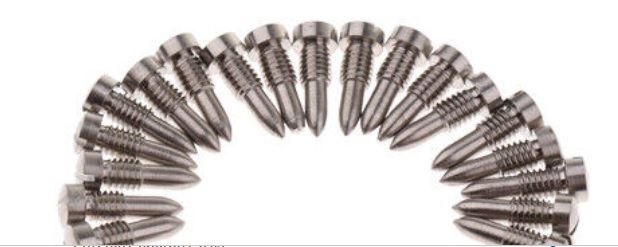Hollow shaft extruder
-
@pakar I don't think, the center hole would need to be bigger than 4mm. Then we can fit a common 4x2 PTFE tube as insulation. Same as with most hotends I know.
I'm not against BLDC motors, they run super smooth and very silent. But we'd need a better interface-board than the O-Drive Arduino-shield@dc42 would it be possible to integrate BLDC support on a small Duet3 board? With a 3x H-bridge as driver, it could be a simple RP2040, I guess.( with the encoder on a state-machine)
-
I thought of another way to support the rollers and my other hobby came handy:
Saxophon repair kits come with these screws.

The rollers would have center holes matching the shape of the screw tip. Voilá, low friction and precise guidance.
-
@o_lampe i did exactly that. Counterbored the stepper shaft and inserted a thinwalled ptfe tube.
-
@tombrazier no need for apologies, those are very informative pictures! I'm on a short vacation right now, but when I'm back I'll try to reproduce the same results on the ingenuity. Curious about the difference!
-
@o_lampe
Option for the o-dive.https://github.com/simplefoc/Arduino-FOC
Mini (<3A board)
https://www.simplefoc.com/simplefoc_mini_product_v1
Available for €12 from https://www.simplefoc.com/simplefoc_mini_product_v1 -
@pakar That's cool. Ordered two right away. Maybe I can finish my RC-balancing bot with these.
-
@o_lampe simplefoc is pretty good, I've been tinkering with them for a while. Definitely worth a try.
-
@CNCModeller I tried to find a tutorial, how to wire the miniFOC board or at least a legend, what all the input pins are. But the github Wiki contains only one sentence: welcome to the Wiki
Most information sounds more like a sales promotion to me.
Did you find something useful? -
@o_lampe do you mean this board? https://docs.simplefoc.com/mini_connect_hardware
-
Just found the
perfect motor/encoder combo: the makerbase SF2804
It's the same motor as FaqT0tum uses in his roller-extruder, but with simpleFOC encoder interface.//edit
forget it, the encoder wouldn't let the filament pass through.... -
@o_lampe I've been tinkering with these...
https://docs.simplefoc.com/arduino_simplefoc_shield_showcase
I've also got 10 of these for a higher power project
https://community.simplefoc.com/t/simplefoc-power-shield-d-beta/2686
They're pretty much plug and play with the associated Arduino examples in the library.
Hope that helps...
-
34g motor (€4).. but torque might be an issue on these at low rpm.
https://www.aliexpress.com/item/1005004901867829.html- a >500ppr encoder with a hole for the shaft.
simplefoc lists the AMT103-V from mouser (€20) that supports up to 2048ppr and is 14-20g depending on selected model.
or
110g motor
https://www.aliexpress.com/item/1005004516876627.html
with hall-sensor, but unsure about what accuracy you can get with the built in hall-sensors. - a >500ppr encoder with a hole for the shaft.
-
@pakar The 34g one has an outer diameter of 33mm. I think this might actually be small enough to mount on a Voron tool head. That's been a bit of a background preoccupation for me. If you want a small and light extruder, then the obvious place to want to mount it is a Voron. So it would be good if it did fit.
-
@tombrazier said in Hollow shaft extruder:
The threaded rod, by the way, is equivalent to putting the bearings at a cant angle.
I compared the VDE100 and the screw-roller extruder. The cant angle of the screw roller seems bigger, but the pitch is only 0.8mm vs 1.5mm of the VDE100. How does that work?
-
@tombrazier said in Hollow shaft extruder:
the obvious place to want to mount it is a Voron. So it would be good if it did fit.
It definitely fits on the smart effector.
Re: torque
FaqT0tum listed the same motor with 100kV ( turns/volt)
But others have 160 or 270kV, which are the hotter versions.
Will be interesting to see, which works best with the simpleFOC-mini at 24V, since it has no current sensors. -
@o_lampe said in Hollow shaft extruder:
I compared the VDE100 and the screw-roller extruder. The cant angle of the screw roller seems bigger, but the pitch is only 0.8mm vs 1.5mm of the VDE100. How does that work?
Does "pitch" mean the pitch of the thread that is cut into the filament?
The threads on a screw roller are already canted. If you tilt the roller in the right direction you can bring the threads level, which would result in no feed on the filament. If you carry on tilting, you'll start getting feed in the opposite direction. The magnitude of the total effect will be the difference between the magnitudes of the two individual effects. Perhaps this is what is happening.
Another alternative is just that there might be a lot of slip or thread compression with that particular design.
Or it may just be that there is a confusion around the word "pitch" - it could be referring the the pitch of the threads on the roller being 0.8mm.
What actual screw roller example were you looking at?
-
-
@o_lampe Where did the 0.8mm pitch number come from? I don't see it in the Skewder_Servo_Extruder project.
-
@tombrazier There are some weird numbers which don't make sense.
The forked version of the Skewder uses a different roller (8.2x0.8), while the original uses 8mm OD bearings, but a M8x0.75 screw?
Even worse, the images aren't correct, too. (says 6mm bearings, but 8mm it is)Anyway, I made the 8.2mm version and it works even with resin-printed rollers.
The pinch-lever does a good job, in release position I can pull out the filament.
But I haven't yet found out how to lock it. I squeezed a 2mm piece of scrap in, but will it hold?
I have ordered two types of motors from aliexpress (2804/100kV and 2805/160kV)
When they arrive, I'll test further. -
BTW: the extruder weights only 24grams w/o motor and encoder
The lightest extruder I had so far weights 47grams w/o motor (sherpa mini)
